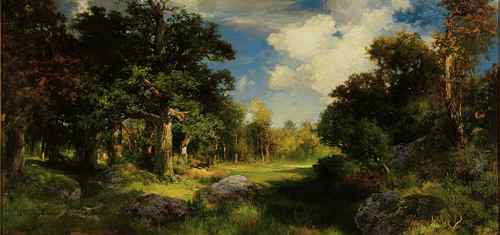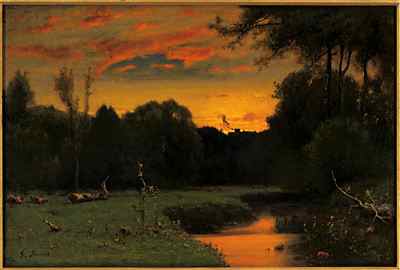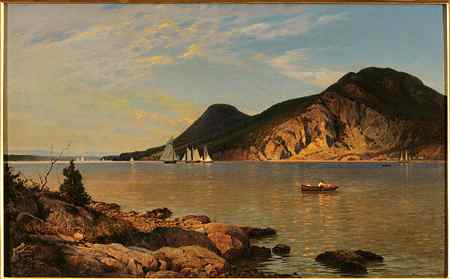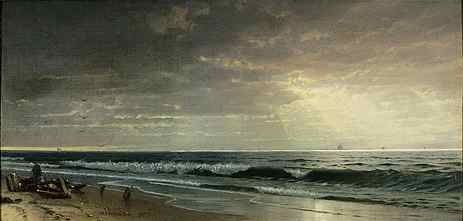Editor's note: The Nassau County Museum of Art
provided source material to Resource Library for the following article
or essay. If you have questions or comments regarding the source material,
please contact the Nassau County Museum of Art directly through either this
phone number or web address:
Poetic Journey: Hudson
River School Paintings from the Grey Collection
January 18 - March 15,
2009
On the anniversary
of the 400th year since Henry Hudson's exploration of what came to be called
the Hudson River, Nassau County Museum of Art  (NCMA)
presents Poetic Journey: Hudson River School Paintings from the Grey
Collection, an exhibition based the extraordinary holdings of Long Island
art collectors David and Laura Grey. Included in this exhibition are works
by masters of the genre such as Thomas Moran, Albert Bierstadt, George Inness
and John Frederick Kensett, among others. Poetic Journey is on view
from January 18, 2009 through March 15, 2009. The exhibition is organized
by Constance Schwartz and Franklin Hill Perrell. (right: Thomas Moran,
Long Island Landscape, 1902, Oil on canvas, 20 x 30 inches. The Grey
Collection, Brookville, New York)
(NCMA)
presents Poetic Journey: Hudson River School Paintings from the Grey
Collection, an exhibition based the extraordinary holdings of Long Island
art collectors David and Laura Grey. Included in this exhibition are works
by masters of the genre such as Thomas Moran, Albert Bierstadt, George Inness
and John Frederick Kensett, among others. Poetic Journey is on view
from January 18, 2009 through March 15, 2009. The exhibition is organized
by Constance Schwartz and Franklin Hill Perrell. (right: Thomas Moran,
Long Island Landscape, 1902, Oil on canvas, 20 x 30 inches. The Grey
Collection, Brookville, New York)
These Hudson River School paintings present a deeply moving
and historic theme, one that has been relatively untouched in recent exhibitions
at this museum. The artists of period, ca. 1840-1880, evolved through the
Romantic spirit inspired by the majesty of the nation's vast and powerful
landscape and came to comprise the first authentic American art movement,
one which defined itself in predominantly American terms with regard to
both subject and style. In depicting the awe-inspiring landscapes of America,
they were inspired by the ideas of the writers Thoreau and Emerson. Their
work reflected a widespread belief that scenes of untouched America had
a purity lacking in historic European landscapes. This fascination with
pristine American scenes combined with the evolving political concept of
manifest destiny to sweep the visual arts of the mid- and late-19th century.
Also drawn from important Long Island collections are the
works of the main exhibition, Long Island Collects, and a companion
exhibition, Andy Warhol Silkscreens. To view wall panels from Long
Island Collects please click here.
Public programs
NCMA is sponsoring several public programs to illuminate
and enhance the experience of viewing the exhibition. Among the events are
talks by Chief Curator Franklin Hill Perrell, Charles A. Riley II, PhD and
art collector David Grey and private tours of the exhibition followed by
elegant teas. For details on these events or to register, call (516) 484-9338,
ext 12 or log onto http://www.nassaumuseum.com/
Wall text from the exhibition
- The Hudson River School paintings from the collection
of Laura and David Grey present a deeply moving and historic theme, one
relatively untouched in recent exhibitions at this museum. The artists
of this period, ca. 1840-1880, evolved through the Romantic spirit inspired
by our nation's vast and powerful landscape. The transcendentalism explored
by the writers Thoreau and Emerson informs these works. The artists, in
recognition of God's handiwork, acknowledged in paint the poets' sense
of the sublime.
-
- The Hudson River School, which included the artists Cole,
Cropsey, Gifford, Inness, Kensett, etc., was the first authentic American
art movement. This seminal group defined itself in predominantly American
terms with regard to both subject and style. As such, they had a mission:
to disseminate awe inspiring images of the American wilderness. Their presentation,
rooted in descriptive literalism, embraced individual differences of approach:
tactility, color, scale, and compositional preferences reflecting the temperament
of each artist. The Hudson River artists taught themselves in the spirit
of Yankee ingenuity and worked with available resources to narrate their
story of the "New World."
-
- Their quest for a formal vocabulary that would come to
terms with their concept of natural perfection ultimately led to Luminism.
This technique of crisp forms, dramatically illuminated in contrasting
light and shade, conveyed a crystalline clarity in atmospheric stillness.
The artists sought to minimize evidence of the human hand by eliminating
painterly gesture through smooth, all-over brushwork. The drama of light,
in golden hues with touches of pink, becomes all-encompassing as if to
manifest the deific or holy in nature.
-
- There was, at this time, a widespread belief that such
American scenes, largely free from human intervention, emblemized a purity
that historic European landscapes lacked. This theme of discovery combined
with the political concept of manifest destiny swept this period of art
throughout the young and growing nation.
-

(above: George Inness, Sunset, ca. 1878-1879, Oil
on canvas, 10 x 15 inches. The Grey Collection, Brookville, New York)

(above: Frank Andersonm Breakneck Mountain, Hudson Highlands,
1878, Oil on canvas, 10 x 16 3/8 inches. The Grey Collection, Brookville,
New York)

(above: William Trost Richards, Along the Atlantic,
1870, Oil on canvas, 8 x 16 inches. The Grey Collection, Brookville, New
York)
Resource Library readers may
also enjoy:
Read more articles and essays concerning this institutional
source by visiting the sub-index page for the Nassau
County Museum of Art in Resource Library
Search Resource
Library for thousands of articles and essays on American art.
Copyright 2009 Traditional Fine Arts Organization, Inc., an Arizona nonprofit corporation. All rights
reserved.
 (NCMA)
presents Poetic Journey: Hudson River School Paintings from the Grey
Collection, an exhibition based the extraordinary holdings of Long Island
art collectors David and Laura Grey. Included in this exhibition are works
by masters of the genre such as Thomas Moran, Albert Bierstadt, George Inness
and John Frederick Kensett, among others. Poetic Journey is on view
from January 18, 2009 through March 15, 2009. The exhibition is organized
by Constance Schwartz and Franklin Hill Perrell. (right: Thomas Moran,
Long Island Landscape, 1902, Oil on canvas, 20 x 30 inches. The Grey
Collection, Brookville, New York)
(NCMA)
presents Poetic Journey: Hudson River School Paintings from the Grey
Collection, an exhibition based the extraordinary holdings of Long Island
art collectors David and Laura Grey. Included in this exhibition are works
by masters of the genre such as Thomas Moran, Albert Bierstadt, George Inness
and John Frederick Kensett, among others. Poetic Journey is on view
from January 18, 2009 through March 15, 2009. The exhibition is organized
by Constance Schwartz and Franklin Hill Perrell. (right: Thomas Moran,
Long Island Landscape, 1902, Oil on canvas, 20 x 30 inches. The Grey
Collection, Brookville, New York)

